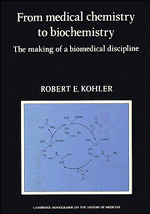Book contents
- Frontmatter
- Contents
- 1 Introduction: On discipline history
- 2 Physiological chemistry in Germany, 1840–1900
- 3 Physiology and British biochemists, 1890–1920
- 4 General biochemistry: the Cambridge school
- 5 European ideals and American realities, 1870–1900
- 6 The reform of medical education in America
- 7 From medical chemistry to biochemistry: the emergence of a discipline
- 8 Unity in diversity: the American Society of Biological Chemists
- 9 The clinical connection: biochemistry as applied science
- 10 Chemical ideals and biochemical practice
- 11 Biological programs
- 12 Epilogue: Toward a molecular biology?
- Location of archival sources and abbreviations
- Notes
- Index
8 - Unity in diversity: the American Society of Biological Chemists
Published online by Cambridge University Press: 07 October 2011
- Frontmatter
- Contents
- 1 Introduction: On discipline history
- 2 Physiological chemistry in Germany, 1840–1900
- 3 Physiology and British biochemists, 1890–1920
- 4 General biochemistry: the Cambridge school
- 5 European ideals and American realities, 1870–1900
- 6 The reform of medical education in America
- 7 From medical chemistry to biochemistry: the emergence of a discipline
- 8 Unity in diversity: the American Society of Biological Chemists
- 9 The clinical connection: biochemistry as applied science
- 10 Chemical ideals and biochemical practice
- 11 Biological programs
- 12 Epilogue: Toward a molecular biology?
- Location of archival sources and abbreviations
- Notes
- Index
Summary
By 1920 departments of biological chemistry were established in most American medical schools. They were equal in status with the older biomedical disciplines and had an equal claim on student time and university resources. Europe had the superstars, but in the United States, even the average medical schools had good facilities and resources for research. Philip Shaffer's ideal in 1915 was a permanent staff of four and a budget of $14,000, including $4,000 for teaching and research. In 1920 Alonzo Taylor had two assistant professors and a budget of $19,650, and a similar plan was proposed by Columbia to the General Education Board. Folin's staff included an associate and an assistant professor, an instructor, and three teaching assistants; his budget was about $16,000, including $4,400 for expenses. Folin eschewed the older pattern of one professor with a retinue of student assistants and technicians. Each professor developed his own line of research and shared equally in training graduate students. In size and general policy, these were typical of the leading departments circa 1920.
The best standard department was a complex institution. In addition to teaching 70 to 120 medical students, Folin's staff managed five to seven doctoral candidates per year, one or two foreign researchers, and two or three advanced medical students. About ten physicians spent a month or so each year on research projects, and Folin kept close contacts with local hospitals.
- Type
- Chapter
- Information
- From Medical Chemistry to BiochemistryThe Making of a Biomedical Discipline, pp. 194 - 214Publisher: Cambridge University PressPrint publication year: 1982



